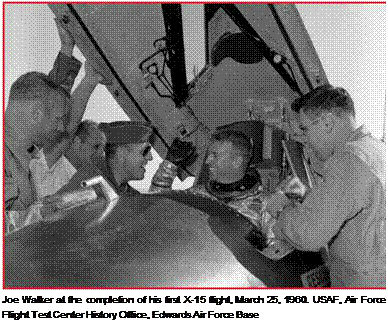ROCKET CONTROLS IN SPACE
The use of rocket controls in flight was demonstrated earlier on the Bell X-1B airplane. Therefore, it was natural that rocket controls would be used for the X-15 as the only effective controls in space, where the aerodynamic forces are inadequate or nonexistent. These low-thrust rocket engines, using a monopropellant (hydrogen peroxide), provided useful control in space and have been used by the Space Shuttle in outer space.
ACCOMPLISHMENTS
All the design goals of the X-15 were met during its flight-test program, and some were surpassed.
The design maximum altitude and Mach number were both reached. The hypersonic research data obtained provided a rich database that confirmed the viability of hypersonic wind tunnel data as well as the usefulness of the limited theoretical analyses available at that time. The airplane proved to be a successful hypersonic vehicle, and the X-15 pilots performed admirably over an almost ten-year period. The program ended when the funding ran out and research experiments no longer justified the associated costs of the flights.
The flight region explored and extended the known range to M=6.7 and an altitude of 354,200 feet. The X-15 pilots explored this hypersonic range and provided data for future manned flights and for manned space vehicles flying from space through the atmosphere to landing, such as the Space Shuttle.
The new large RMI rocket motor performed well, providing the acceleration needed and with an operating efficiency of about 97 percent in support of obtaining mission data. There were no blowups in flight, and although the partial thrust use and subsequent restart capability were not reliable, the engine was able to position the airplane in the flight regions to be studied.
The MH-96 adaptive control system proved adequate and useful for stability on all three axes of flight. Some form of adaptive controls (controls that adapt automatically to the changing flight environment that was encountered during the flight of the airplane) have been used by high- performance aircraft in the fifty-plus years since the X-15.
All three control systems worked. The pilots preferred the power assisted controls over pure manual controls for use in the atmosphere, and the reaction rocket controls performed well in space and where the aerodynamic forces were insufficient. They have since been incorporated into the design of the Space Shuttle. The transition
in use of the control system from space to the atmosphere where aerodynamic controls took over was easily effected.
The high-temperature material, Inconel X, maintained its strength as predicted at the high temperatures obtained in flight, and it supported the flight loads. This design approach, which allowed for thermal expansion of the hot structure while the cold understructure remained unstressed, was ultimately successful after the engineering team made a few corrections following initial hot flights.
The aero-thermodynamic analytical predictions were considerably higher than the actual measurements; analytics can now reliably use empirical data obtained from these flights. The research team also learned that the predicted high stagnation temperatures occurred where air could enter small gaps in wing construction, which then burned internal wires and structural features.
A ball nose instrument was attached at the extreme nose of the airplane and utilized Inconel X to withstand the high temperatures of hypersonic flight. This instrument, which provided angle of attack and angle of yaw data to the pilot, was necessary for flying and controlling the airplane at the high-speed and high-temperature conditions.
Replacement of ailerons was accomplished by using the horizontal stabilizer differentially deflected (i. e., right stabilizer angle increased while the left stabilizer angle decreased, and vice versa), providing satisfactory roll control and simplifying the knowledge of airflow conditions at the tail.

 As a research airplane, the X-15 was also a useful platform for doing experiments at hypersonic speeds. Most important, the repeated and successful utility of this airplane over highly accelerated and decelerated flight from space to landing demonstrated that piloted aircraft are suitable for manned controlled return from space and for missions in the hypersonic regime.
As a research airplane, the X-15 was also a useful platform for doing experiments at hypersonic speeds. Most important, the repeated and successful utility of this airplane over highly accelerated and decelerated flight from space to landing demonstrated that piloted aircraft are suitable for manned controlled return from space and for missions in the hypersonic regime.










